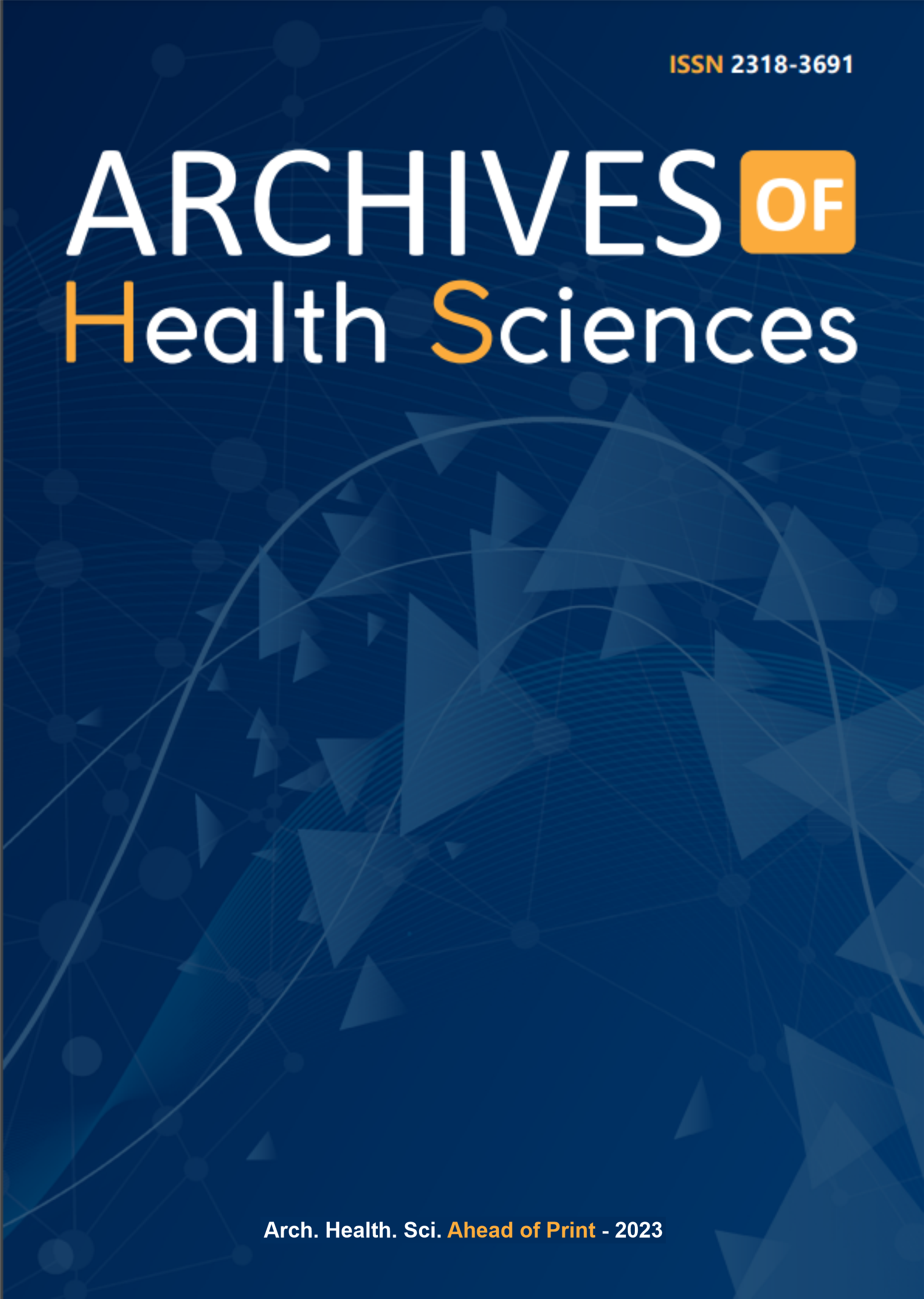Hypoglycemic effects of bean (Phaseolus vulgaris L.) in rats with diabetes mellitus
DOI:
https://doi.org/10.17696/2318-3691.30.1.2023.169Keywords:
Diabetes Mellitus. Phaseolus. Hypoglycemia. Nutritional Sciences. Health Promotion. Metabolic Diseases.Abstract
Introduction: Beans are a legume with a high content of proteins, complex carbohydrates, minerals and vitamins. Epidemiological research points out that its continuous intake is associated with a large number of health improvements, among them the reduction in the risk of developing non-transmissible chronic diseases, such as diabetes mellitus (DM). Objective: To verify in the literature the hypoglycemic effect of beans in diabetic rodents. Methods: This is an integrative review carried out in the Science Direct, PubMed and Scopus databases using the descriptors “Phaseolus vulgaris” and “diabetes mellitus”. Original articles published between 2015 and 2020 in Portuguese, Spanish and English were included. Additionally, publications that did not present the proposed subject in the article abstract, review articles, research that did not use experimentation in rodents and duplicate publications were excluded. Results: The use of beans or preparations based on this food in diabetic rodents decreased glycaemia and glucose hemoglobin, triglycerides, cholesterol, low-density lipoproteins, levels of albumin and urea in the urine, and increased insulin in the blood and clearance of creatinine. In addition, elimination of ammonium groups, regulation of inflammation, oxidative response, cell signaling and apoptosis were observed. Conclusion: The studies presented show the effectiveness of the use of beans in reducing glycemic levels in diabetic rodents. It is noteworthy that more studies should be carried out to test its benefits in humans, since the use of this food would be an alternative method in the treatment of this pathology.
References
Souza DM. Efeito do processamento doméstico de feijão preto (phaseolus vulgaris l.) sobre o perfil de compostos fenólicos solúveis e insolúveis e sua capacidade antioxidante [dissertação na Internet]. Niterói: Universidade Federal Fluminense; 2017 [acesso em 2019 nov 01]. Disponível em: https://app.uff.br/riuff/handle/1/5816
Pinto JV. Propriedades físicas, químicas, nutricionais e tecnológicas de feijões (phaseolus vulgaris l.) de diferentes grupos de cor [dissertação na Internet]. Goiás: Universidade Federal De Goiás; 2016 [acesso em 2019 nov 01]. Disponível em: https://repositorio.bc.ufg.br/tede/handle/tede/6848
Silva D, Freitas T, Sabóia R, Damasceno K, Rocha M, Carvalho C, et al. Consumo de feijões (Phaseolus) e seu impacto na resposta glicêmica pós-prandial. RAS [periódico na Internet]. 2019 [acesso 2019 nov 01];17(59):111-21. DOI: https://doi.org/10.13037/ras.vol17n59.5826
Araújo R, Aedo-Munõs E, Moser L, Antoniêtto D, Miarka B, Brito C. Efeitos da suplementação de faseolamina e exercício aeróbio na glicemia e massa corporal de ratos Wistar. Motricidade [periódico na Internet]. 2019 [acesso em 2019 nov 04];15(3):81-6. DOI: 10.6070/motricidade.7189
Ministério da Saúde. Guia alimentar para a população brasileira [monografia na internet]. 2ª ed. Brasília, DF: Ministério da Saúde; 2014 [acesso em 2019 nov 04]. Disponível em: http://bvsms.saude.gov.br/bvs/publicacoes/guia_alimentar_populacao_brasileira_2ed.pdf
Xavier AT, Nunes JS. Tratamento de diabetes mellitus com plantas medicinais. FAEMA [periódico na Internet]. 2018 [acesso em 2019 nov 04];9:603-9. DOI: https://doi.org/10.31072/rcf.v9iedesp.616
Bertonhi L, Dias J. Diabetes mellitus tipo 2: aspectos clínicos, tratamento e conduta dietoterápica. Ciênc Nutric [periódico na Internet]. 2018 [acesso em 2019 nov 04];2(2):1-10. Disponível em: https://unifafibe.com.br/revistasonline/arquivos/cienciasnutricionaisonline/sumario/62/18042018212025.pdf
Ministério da Saúde. Protocolo clínico e diretrizes terapêuticas diabetes mellitus tipo 1 [monografia na internet]. Brasília, DF: Ministério da Saúde; 2020 [acesso em 2019 nov 04]. Disponível em: https://bvsms.saude.gov.br/bvs/publicacoes/protocolo_clinico_terapeuticas_diabete_melito.pdf
Kyznietsova MY, Halenova TI, Savchuk OM, Vereschaka VV, Ostapchenko LI. Carbohydrate metabolism in type 1 diabetic rats under the conditions of the kidney bean pods aqueous extract application. Fiziol Zh [periódico na Internet]. 2015 [acesso em 2019 out 30];61(6):96-103. DOI: 10.15407/fz61.06.096
Lomas-Soria C, Pérez-Ramírez I, Caballero-Pérez J, Guevara-Gonzalez R, Guevara-Olvera L, et al. Cooked common beans (Phaseolus vulgaris L.) modulate renal genes in streptozotocin-induced diabetic rats. J Nutr Biochem [periódico na Internet]. 2015 [acesso em 2019 out 28];26(7):761-8. DOI: 10.1016/j.jnutbio.2015.02.006
Almuaigel M, Seif M, Albuali H, Alharbi O, Alhawash A. Hypoglycemic and hypolipidemic effects of aqueous extract of Phaseolus vulgaris pods in streptozotocin-diabetic rats. Pharmacother Biomed [periódico na Internet]. 2017 [acesso em 2019 out 28];94:742-6. DOI: 10.1016/j.biopha.2017.07.135
Sidorova Y, Shipelin V, Mazo V, Zorin S, Petrov N, Kochetkova A. hypoglycemic and hypolipidemic effect of vaccinium myrtillus l. leaf and phaseolus vulgaris l. seed coat extracts in diabetic rats. Nutrition [periódico na Internet]. 2017 [acesso em 2019 out 30];41:107-12. DOI: 10.1016/j.nut.2017.04.010
Valencia-Mejía V, Batista K, Fernández J, Fernandes K. Antihyperglycemic and hypoglycemic activity of naturally occurring peptides and protein hydrolysates from easy-to-cook and hard-to-cook beans (Phaseolus vulgaris L.). Food Res Int [periódico na Internet]. 2019 [acesso em 2019 out 28];121:238-46. DOI: 10.1016/j.foodres.2019.03.043
Nuñez-Aragón P, Segura-Campos M, Negrete-León E, Acevedo-Fernández J, Betancur-Ancona D, Chel-Guerrero L, et al. Protein Hydrolysates And Ultrafiltered < 1 Kda Fractions From phaseolus lunatus, phaseolus vulgaris and mucuna pruriens exhibit antihyperglycemic activity, intestinal glucose absorption and α-glucosidase inhibition with no acute toxicity in rodents. J Sci Food Agric [periódico na Internet]. 2019 [acesso em 2019 out 29];99(2):587-95. DOI: https://doi.org/10.1002/jsfa.9219
Halenova T, Raksha N, Kravchenko O, Vovk T, Yurchenko A, Vareniuk I, et al. Hypoglycemic activity of Phaseolus Vulgaris (L.) aqueous extract in type 1 diabetic rats. Curri Issues Pharm Med Sci [periódico na Internet]. 2019 [acesso em 2019 out 29];32(4):210-8. DOI: 10.2478/cipms-2019-0036
Obonyo HR, Selvi S. Evaluation of hydrated extract of Phaseolus Vulgaris L. (bean plant) ypoglycemia and hypolipidemic in streptozotocin-induced diabetic albino Wistar rats. Int J Res Pharm Sci [periódico na Internet]. 2019 [acesso em 2019 out 29];10(4): 3704-10. DOI: 10.26452/ijrps.v10i4.1757
Bai Z, Meng J, Huang X, Wu G, Zuo S, Nie S. Comparative study on antidiabetic function of six legume crude polysaccharides. Int J Biol Macromol [periódico na Internet]. 2020 [acesso em 2019 out 30];154:25-30. DOI: https://doi.org/10.1016/j.ijbiomac.2020.03.072
Liu C, Wu D, Zheng X, Li P, Li L. Efficacy and safety of metformin for patients with type 1 diabetes mellitus: a meta-analysis. Diabetes Technol Therapeut [periódico na Internet]. 2015 [acesso em 2019 out 30];17(2):142-8. DOI: 10.1089/dia.2014.0190
Downloads
Published
Issue
Section
License
Copyright (c) 2023 Archives Health Sciences

This work is licensed under a Creative Commons Attribution-NonCommercial-ShareAlike 4.0 International License.










